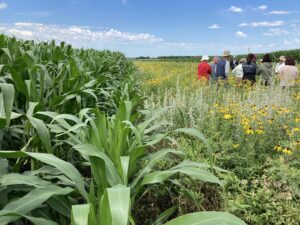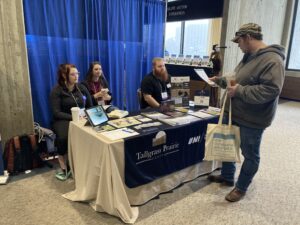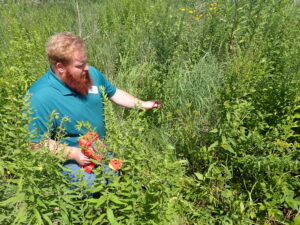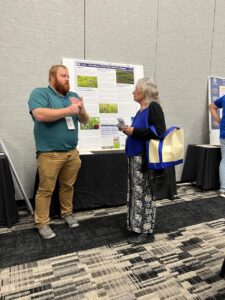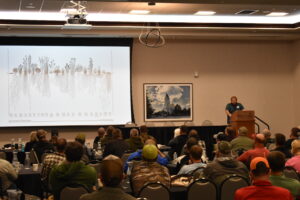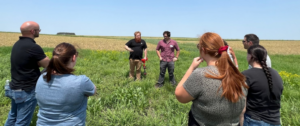Final report for LNC19-425
Project Information
Professional Farm Managers (PFMs) manage millions of acres on behalf of landowners in the Upper Midwest, but are primarily accredited based on their knowledge of farm business, crop production and real estate appraisal. They face unique challenges in addressing conservation issues while pursuing the priorities of client landowners and negotiating annual lease agreements with farm operators. Surveys indicate there is strong interest in conservation among both non-operating landowners and farmers. Our project, “Towards widespread adoption of prairie conservation strips: case studies increase expertise of professional farm managers, landowners and farmers” addresses barriers faced by farmers, landowners, PFMs and conservation planners to improve soil health, water quality, wildlife habitat and thus rural quality of life in the Upper Midwest. Planting 10% of fields to prairie contour buffer strips can be as effective and more economical than cover crops; converting marginal land to prairie can improve overall farm profitability.
We will assemble an advisory committee consisting of farmers, non-farming landowners, conservation professionals, and PFMs. Building on the work of Iowa State University (ISU), the Natural Resources Conservation Service, and others involved in implementing prairie strips across the Midwest, we will develop 6-10 case studies from existing projects representing a range of farmer-landowner arrangements. We will also develop case studies for 1-2 new sites, covering financial analysis of alternatives, planning, and implementation. PFMs and conservation planners will gain greater knowledge, skills and confidence in their ability to provide prairie consultation for their clients. Farmers and landowners will better understand the critical information needed for planning and implementing these projects.
We will share case studies through Tallgrass Prairie Center (TPC) field days and winter meetings, a webinar, and partner networks: the American Society of Farm Managers and Rural Appraisers (ASFMRA), two farm management companies, and ISU Science-based Trials of Rowcrops Integrated with Prairie Strips (STRIPS). Our strategy of case-based and peer-to-peer learning promotes more engaged learning and greater consideration of environmentally sustainable practices. We will attempt to quantify the use of the finished case studies by PFMs and conservation planners, and assess changes in knowledge, skills and confidence at multiple points throughout the project using post-event surveys and interviews, with assistance from an extension rural sociologist.
On a systems level, this project aims to improve the profitability of farmer and associated agricultural businesses, environmental sustainability and rural quality of life by increasing biodiversity and native perennial vegetation in corn-soybean systems.
Professional farm managers and conservation planners will gain greater knowledge, skills and confidence in advising their landowner clients on strategic use of prairie for soil and water conservation.
Landowners and farmers will become aware of critical information from a trusted source (PFMs and peers) to effectively address profitability and environmental sustainability concerns.
PFMs and conservation planners will use case studies and hands-on experiences to support client landowner decision making and effective communication with farmer operators.
With greater adoption of prairie strips, corn-soybean cropping systems and local communities will benefit from increased biodiversity provided by diverse, native vegetation.
Professional Farm Managers (PFMs) manage millions of acres on behalf of landowners in the Upper Midwest, but are primarily accredited based on their knowledge of farm business, crop production and real estate appraisal. They face unique challenges in addressing conservation issues while pursuing the priorities of client landowners and negotiating annual lease agreements with farm operators. Surveys indicate there is strong interest in conservation among both non-operating landowners and farmers. Our project, “Towards widespread adoption of prairie conservation strips: case studies increase expertise of professional farm managers, landowners and farmers” addresses barriers faced by farmers, landowners, PFMs and conservation planners to improve soil health, water quality, wildlife habitat and thus rural quality of life in the Upper Midwest. Planting 10% of fields to prairie contour buffer strips can be as effective and more economical than cover crops; converting marginal land to prairie can improve overall farm profitability.
We will assemble an advisory committee consisting of farmers, non-farming landowners, conservation professionals, and PFMs. Building on the work of Iowa State University (ISU), the Natural Resources Conservation Service, and others involved in implementing prairie strips across the Midwest, we will develop 6-10 case studies from existing projects representing a range of farmer-landowner arrangements. We will also develop case studies for 1-2 new sites, covering financial analysis of alternatives, planning, and implementation. PFMs and conservation planners will gain greater knowledge, skills and confidence in their ability to provide prairie consultation for their clients. Farmers and landowners will better understand the critical information needed for planning and implementing these projects.
We will share case studies through Tallgrass Prairie Center (TPC) field days and winter meetings, a webinar, and partner networks: the American Society of Farm Managers and Rural Appraisers (ASFMRA), two farm management companies, and ISU Science-based Trials of Rowcrops Integrated with Prairie Strips (STRIPS). Our strategy of case-based and peer-to-peer learning promotes more engaged learning and greater consideration of environmentally sustainable practices. We will attempt to quantify the use of the finished case studies by PFMs and conservation planners, and assess changes in knowledge, skills and confidence at multiple points throughout the project using post-event surveys and interviews, with assistance from an extension rural sociologist.
On a systems level, this project aims to improve the profitability of farmer and associated agricultural businesses, environmental sustainability and rural quality of life by increasing biodiversity and native perennial vegetation in corn-soybean systems.
Cooperators
Research
Education
We will share case studies through Tallgrass Prairie Center (TPC) field days and winter meetings, a webinar, and partner networks: the American Society of Farm Managers and Rural Appraisers (ASFMRA), two farm management companies, and ISU Science-based Trials of Rowcrops Integrated with Prairie Strips (STRIPS). Our strategy of case-based and peer-to-peer learning promotes more engaged learning and greater consideration of environmentally sustainable practices. We will attempt to quantify the use of the finished case studies by PFMs and conservation planners, and assess changes in knowledge, skills and confidence at multiple points throughout the project using post-event surveys and interviews, with assistance from an extension rural sociologist.
Project Activities
Educational & Outreach Activities
Participation Summary:
We routinely field questions (phone, email) from farmers and landowners about installation of prairie on their farms, including prairie strip installations. These questions help to inform our education and outreach events so we include them here.
In response to the most common question asked by farm operators about prairie strips, we purchased a tile camera and began doing tile line investigations. We recorded tile line video from 18 tiles on 9 farms, involving 10 farmers and 7 conservation professionals. We are seeking funding to edit the camera footage and produce an educational video.
We held a Virtual field day on dormant seeding of prairie strips at our first of two new demonstration sites on November 19 2020. We used a combination of recorded video to demonstrate seeding techniques in late fall, and live streaming showing seeding equipment, followed by Q&A. The live session had 60 (3 farmer/30 ag professional) attendees, and the YouTube video has had 442 views (composition unknown).
For our regular winter meeting of the Agricultural Conservation Working Group on March 9, 2021, we responded to member interest and need for prescribed fire services. It is difficult to find a contractor who will come out and burn a CRP field or prairie strip, and there are structural reasons for this involving insurance availability. The invited panelists represented private contractors, County Conservation Boards, Pheasants Forever, and representatives of State Fire Councils; we heard from practitioners in Nebraska and Missouri as well as Iowa. The session attracted 3 farmers and 70 professionals; we have not posted it on YouTube.
We have continued our tile camera investigations and have secured funding to continue investigations and to create a video presentation. Additional footage has been taken, which has given us opportunities to further work with farmers in the field to answer their questions about prairie and tile. Additionally, the Sloan Farm case study will feature information and images about the tile camera as Richard Sloan has partnered with us to conduct investigations on his farm since 2019. We have also used the tile camera at DeWall Farm and will likely use it at future case study participants’ farms.
We participated in a prairie strip field day in Mower County, Minnesota on September 15th, 2021 to offer up our best implementation and management practices for prairie strip implementation. In addition to sharing this information we identified a case study participant in Wayne DeWall and potential ag educators at both Mower County Soil and Water Conservation District and the Minnesota Department of Agriculture to assist in sharing information in the future. The field day attracted 30 farmers 12 professionals.
The ISU STRIPS team hosted a symposium on prairie strips related research on January 10th, 2022. We shared some of our insights garnered from the Luze Farm case study conducted thus far, one being how many of the participants have stressed the importance of strong relationships amongst farmers, landowners, government employees, and technical service providers. The event had approximately 40 participants, with 20 presenting research topics.
We participated in Learning Circles for Women in Agriculture, organized by American Farmland Trust, for farmers in Minnesota, Wisconsin, Nebraska, and Kansas (November 10, 2021 and March 3, 2022. We also contributed to multiple planning meetings leading up to each webinar. One of our roles has been to link ag educators and other conservation professionals to local/regional expertise on prairie restoration. Our primary role has been to share case studies of prairie strip implementation. (We specifically highlighted the Luze Case Study because it involves a female landowner and professional farm manager.) An additional benefit of these Learning Circles for us has been to interact with professionals and landowners beyond Iowa. Between both learning circles, approximately 30 farmers and 20 professionals have been reached. We will be participating in at least one more Learning Circle for Missouri and Illinois.
As in-person tabling opportunities have opened up, we have used the case studies as the focal point of our interactions at two events: the Practical Farmers of Iowa annual conference (January 21 and 22, 2022) and the Niman Ranch Trade Show (March 16, 2022). We currently have two case studies with eye-catching designs and have handed them out at these events. We are also using the events as an opportunity to find new potential case studies.
We missed a key outreach event, the Iowa chapter of ASFMRA’s annual meeting, in 2021. Just as the project was getting off the ground (February 2020), our Prairie on Farms program manager moved to a new position. The position was filled in June, 2020 but vacated again in April 2021. Staff turnover plus pandemic conditions delayed the development of case studies. We also did not anticipate the need to commit additional time to investigate the financial aspects of the case studies. However, we have now produced two case studies with two more in progress. We are now well-positioned to attend upcoming outreach events and disseminate the case studies widely amongst farmers, landowners, and professional farm managers.
2022
All four currently complete case studies are digitally available for viewing and downloading on our website. The DeWall case study can also be found at Mower County (MN) Soil and Water Conservation District’s website.
Outreach via our professional farm manager partners was especially fruitful in this year of the project. With Hertz, we delivered presentations of the case studies at two of their landowner seminars, reaching approximately 150 landowners and two dozen professional farm managers. Attending these events also offered an opportunity to meet and talk with both of these groups one on one as well. In addition to the seminars, we gave a presentation at the Iowa chapter of American Society of Farm Managers and Rural Appraisers (ASFMRA). Reaching approximately 50 farm managers located across the state achieved a major milestone in reaching that audience.
We held an in-person field day at Roadman Farm where participants learned about the farms history and how the prairie strips have been implemented. Attendees also heard from a NRCS representative and were offered an in-field botany training on managing prairie strips, specifically. This field day directly led to finding a new case study participant who we are partnering with to implement a new planting on their farm. We are currently working with another landowner who attended this field day who is interested in doing a similar project as well.
In-person tabling events are a valuable avenue for reaching landowners, farmers, and other farm professionals. The four completed case studies were used as cornerstones in our engagement with these groups. Events attended included the Practical Farmers of Iowa annual conference, the Iowa Farmers Union annual meeting, and the Iowa Prairie Networks winter meeting.
We participated in several talks and presentations hosted by other organizations, including: two additional Women’s Learning Circles hosted by American Farmland Trust, Iowa State University’s STRIPS team’s Stakeholder Field Day, and the Iowa Organic Associations field day at Burtal Farms. The insights provided by the case studies are invaluable when delivering talks to such a wide variety of audiences. Having the unique perspectives offered by professional farm managers adds to the depth of advice we can offer at these events.
2023
2023 saw the continued focus of disseminating the case studies via education and outreach activities to reach farmers, landowners, and agricultural professionals. All case studies are available on our website.
The highlight of this year’s outreach centered around four trainings held for the Farm Service Agency (FSA) and Natural Resources Conservation Service (NRCS) employees about prairie strips, organized by Iowa State University’s STRIPS team. As the people responsible for administering the Conservation Reserve Program (CRP), this group offered a major opportunity to proliferate the case studies and the practical knowledge they offer about successfully installing prairie as a conservation practice.
We led a station during the field day portion of each training session focused on root-infiltration in tile lines and vegetation, including best planting and management practices. Copies of the case studies were referenced and available for attendees to take with them. Evaluation of the trainings revealed this station had an overwhelmingly positive impact, with 46% of survey participants rated this station as “Extremely Well” and 36% as “Very Well”.
Tabling events continued to be an important avenue of outreach. One notable event was the North American Prairie Conference held in Des Moines which attracted over 600 attendees from across the country. In addition to our table where the case studies were emphasized, we also participated in the poster session. While the event is focused on prairie restoration professionals, many landowners also attended and talked about the potential of prairie on their farms with TPC staff.
A January 2024 article from National Geographic highlighting the imperiled state of the monarch butterfly included upper Midwest restoration efforts to provide more habitat. The author and photographer both visited the Roadman demonstration site to get a better grasp on how prairie strips are providing habitat to pollinators. The Sloan case study was also featured in two photos.
A 90-minute documentary film by Perennial Films, Prairie Prophecy, is expected to debut in Fall 2024 or Winter 2025. While we can’t be certain about the contents, the film crew did spend significant time filming at Roadman Prairie in summer 2023 capturing interviews with TPC staff and on-the-ground and drone imagery. The producers generously shared their imagery with us and we are already using it in our educational materials.
Conclusion
This project advanced the adoption of prairie strips, an unfamiliar but particularly effective conservation practice with clear economic, environmental and social benefits, in several important ways. First, our case studies documented real-life prairie strip projects on a variety of farms, with candid opinions and realistic accounting of costs and logistical challenges. We avoided pure “testimonials” by enthusiastic adopters, to embrace a more complex reality. This type of information is invaluable to decision-makers, and will endure for many years.
Second, we explored a little-known (to us anyway) target of conservation education, the professional farm manager. Through seminars, field days, direct outreach, and technical support, we reached beyond the owner-operators and conservation professionals that are the typical target of conservation education. By participating in professional conferences and landowner meetings held by farm management companies, and by working with a few individual farm managers, we tapped into a sector of the farm economy that oversees land use decisions over millions of acres.
Finally, we made big strides as an organization in bringing two worlds together: the prairie restoration community, and the world of agricultural conservation. The members of our farmer advisory committee provided us with critical insights into the questions, priorities and needs of agricultural landowners. We learned, and responded as best we could to those priorities. Farm managers became more aware of the extraordinary passion that many landowners feel towards prairie, and the lengths they will go to incorporate it on their farms through farm bill conservation programs when given enough support. Certainly, the typical landowner is satisfied with meeting minimum practice standards. But for Professional Farm Management businesses to succeed, they must also serve landowners in the vanguard. The result has been expanding opportunities for restoration of native prairie on farms through mutual growth and collaboration.
We are grateful to NCR-SARE for the opportunity to pursue this project, and look forward to spreading the case studies and documenting their long term impacts.
Learning Outcomes
- Prairie restoration implementation
- Prairie management
- Botany
Project Outcomes
Prairie Strips
The following are quotes from farmers and landowners in Iowa about their success with prairie strips:
“I think it’s effective in strategic places. It’s more diverse than just a typical brome grass seeding like how a lot of CRP that we use started out as.”
“Prairie is a great fit in areas where you’re trying to make the farm more efficient, whether it's taking vulnerable areas out of production, managing low production areas, so that you’re not wasting inputs and wasting money for people. Or if you have a landowner that’s very interested in wildlife and habitat, you know, those are the areas where it needs to be.”
“Prairie strips can be an easier practice than, say, something like cover crops.”
“The flexibility with the layout makes it much easier on a farm operator, same with rules about headlands and driving on them if needed when planting and harvesting.”
“The intrinsic habitat benefits. It’s not just for erosion control or not just for water quality. It ticks a lot of boxes and I think people really enjoy the beauty. There’s a real emotional connection.”
“I think it’s one piece in putting together this puzzle of effective conservation. Agriculture is a long, ongoing experiment that we’ve been doing in Iowa for 150 or 200 years. The economic side of it is there, which has provided a lot of benefits and a lot of good livelihoods. But there have been unintended negative environmental consequences that we didn’t anticipate. The loss of soil, dirty water, the lack of habitat for wildlife… I love that prairie is a foil to that. The simplicity of taking the plants that were here that provided clean water, that provided the topsoil. The wildlife will respond best to the native prairie plants that they need for their life cycles.”
